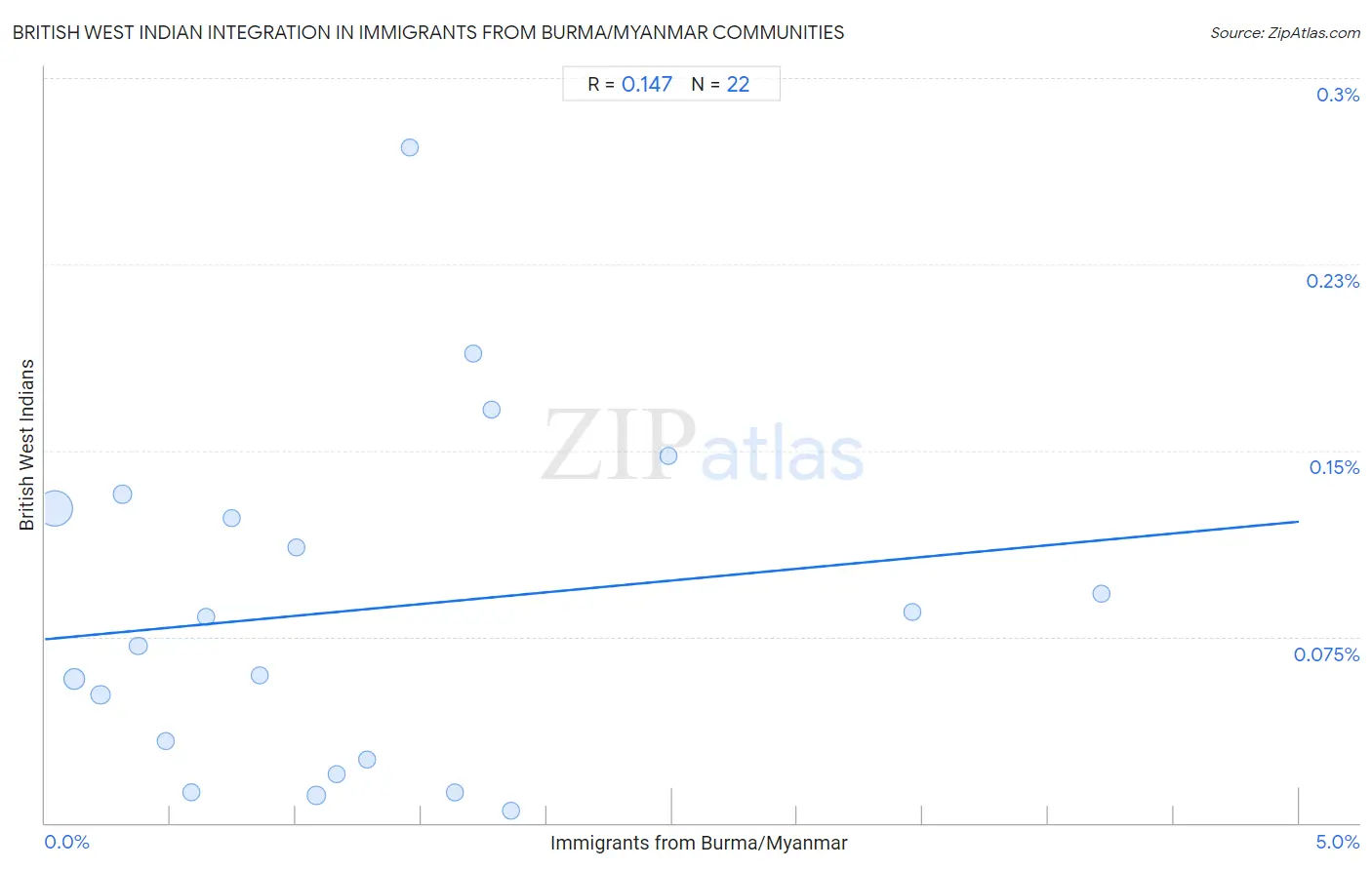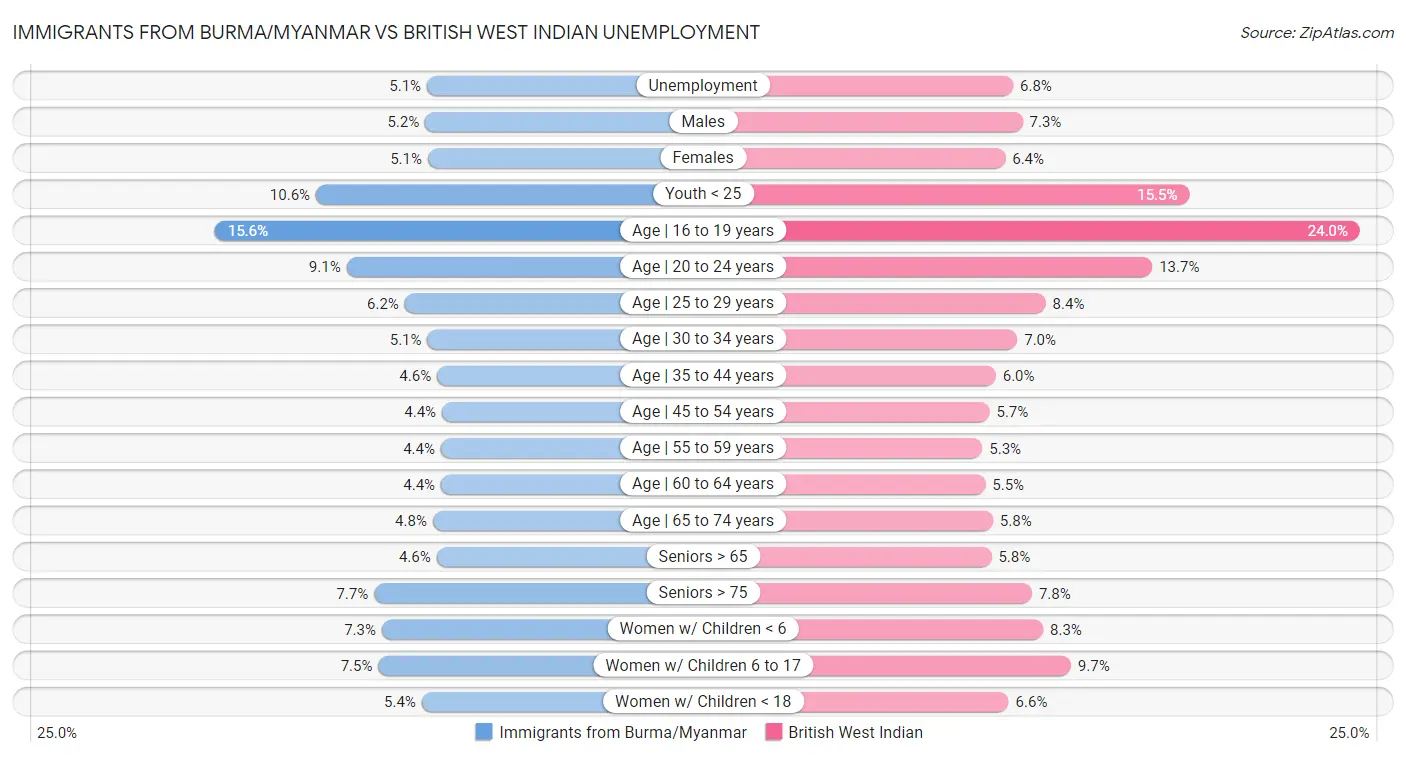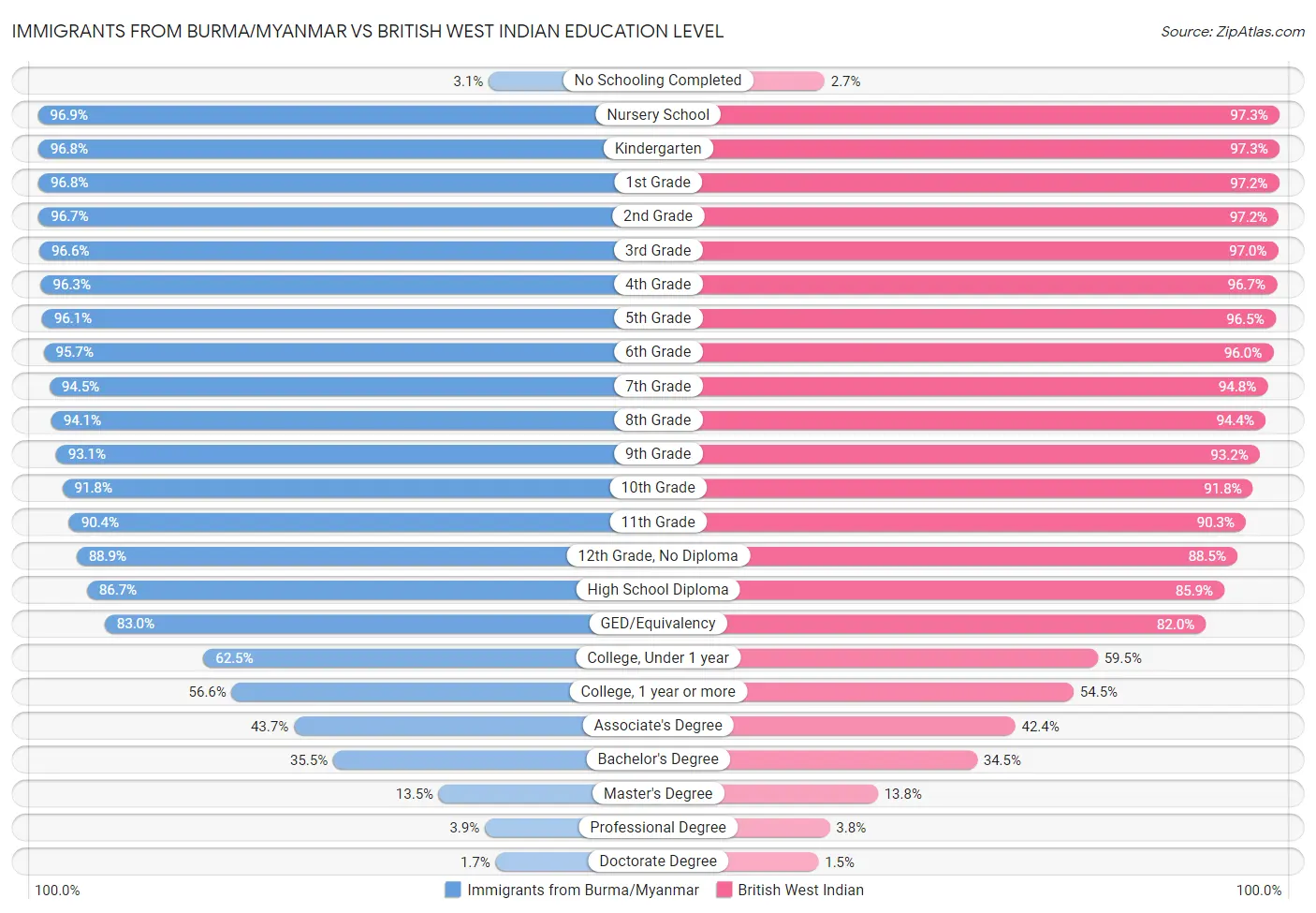Immigrants from Burma/Myanmar vs British West Indian Community Comparison
COMPARE
Immigrants from Burma/Myanmar
British West Indian
Social Comparison
Social Comparison
Immigrants from Burma/Myanmar
British West Indians
3,365
SOCIAL INDEX
31.2/ 100
SOCIAL RATING
222nd/ 347
SOCIAL RANK
938
SOCIAL INDEX
6.9/ 100
SOCIAL RATING
333rd/ 347
SOCIAL RANK
British West Indian Integration in Immigrants from Burma/Myanmar Communities
The statistical analysis conducted on geographies consisting of 86,692,822 people shows a poor positive correlation between the proportion of British West Indians within Immigrant from Burma/Myanmar communities in the United States with a correlation coefficient (R) of 0.147. On average, for every 1% (one percent) increase in Immigrants from Burma/Myanmar within a typical geography, there is an increase of 0.009% in British West Indians. To illustrate, in a geography comprising of 100,000 individuals, a rise of 1,000 Immigrants from Burma/Myanmar corresponds to an increase of 9.5 British West Indians.

Immigrants from Burma/Myanmar vs British West Indian Income
When considering income, the most significant differences between Immigrants from Burma/Myanmar and British West Indian communities in the United States are seen in wage/income gap (22.8% compared to 18.0%, a difference of 26.8%), householder income over 65 years ($57,114 compared to $51,463, a difference of 11.0%), and householder income ages 45 - 64 years ($91,385 compared to $85,571, a difference of 6.8%). Conversely, both communities are more comparable in terms of per capita income ($39,827 compared to $40,330, a difference of 1.3%), median earnings ($43,998 compared to $44,552, a difference of 1.3%), and median male earnings ($50,298 compared to $49,636, a difference of 1.3%).

| Income Metric | Immigrants from Burma/Myanmar | British West Indian |
| Per Capita Income | Tragic $39,827 | Tragic $40,330 |
| Median Family Income | Tragic $94,472 | Tragic $88,987 |
| Median Household Income | Tragic $78,682 | Tragic $75,647 |
| Median Earnings | Tragic $43,998 | Tragic $44,552 |
| Median Male Earnings | Tragic $50,298 | Tragic $49,636 |
| Median Female Earnings | Tragic $38,028 | Good $40,299 |
| Householder Age | Under 25 years | Tragic $48,749 | Fair $51,844 |
| Householder Age | 25 - 44 years | Tragic $86,736 | Tragic $85,565 |
| Householder Age | 45 - 64 years | Tragic $91,385 | Tragic $85,571 |
| Householder Age | Over 65 years | Tragic $57,114 | Tragic $51,463 |
| Wage/Income Gap | Exceptional 22.8% | Exceptional 18.0% |
Immigrants from Burma/Myanmar vs British West Indian Poverty
When considering poverty, the most significant differences between Immigrants from Burma/Myanmar and British West Indian communities in the United States are seen in seniors poverty over the age of 75 (12.1% compared to 17.4%, a difference of 44.3%), receiving food stamps (12.9% compared to 17.9%, a difference of 39.0%), and seniors poverty over the age of 65 (11.3% compared to 15.6%, a difference of 38.6%). Conversely, both communities are more comparable in terms of single female poverty (22.6% compared to 22.8%, a difference of 1.2%), single male poverty (13.1% compared to 13.4%, a difference of 1.8%), and female poverty among 18-24 year olds (21.6% compared to 21.2%, a difference of 1.9%).

| Poverty Metric | Immigrants from Burma/Myanmar | British West Indian |
| Poverty | Tragic 14.2% | Tragic 15.9% |
| Families | Tragic 10.5% | Tragic 12.4% |
| Males | Tragic 13.0% | Tragic 14.6% |
| Females | Tragic 15.4% | Tragic 17.0% |
| Females 18 to 24 years | Tragic 21.6% | Tragic 21.2% |
| Females 25 to 34 years | Tragic 15.2% | Tragic 15.6% |
| Children Under 5 years | Tragic 20.4% | Tragic 21.4% |
| Children Under 16 years | Tragic 19.4% | Tragic 21.3% |
| Boys Under 16 years | Tragic 19.2% | Tragic 21.6% |
| Girls Under 16 years | Tragic 19.7% | Tragic 21.3% |
| Single Males | Poor 13.1% | Tragic 13.4% |
| Single Females | Tragic 22.6% | Tragic 22.8% |
| Single Fathers | Fair 16.5% | Tragic 17.7% |
| Single Mothers | Tragic 30.6% | Tragic 31.5% |
| Married Couples | Tragic 6.0% | Tragic 7.1% |
| Seniors Over 65 years | Fair 11.3% | Tragic 15.6% |
| Seniors Over 75 years | Good 12.1% | Tragic 17.4% |
| Receiving Food Stamps | Tragic 12.9% | Tragic 17.9% |
Immigrants from Burma/Myanmar vs British West Indian Unemployment
When considering unemployment, the most significant differences between Immigrants from Burma/Myanmar and British West Indian communities in the United States are seen in unemployment among ages 16 to 19 years (15.6% compared to 24.0%, a difference of 53.8%), unemployment among ages 20 to 24 years (9.1% compared to 13.7%, a difference of 50.9%), and unemployment among youth under 25 years (10.6% compared to 15.5%, a difference of 46.7%). Conversely, both communities are more comparable in terms of unemployment among seniors over 75 years (7.7% compared to 7.8%, a difference of 0.58%), unemployment among women with children under 6 years (7.3% compared to 8.3%, a difference of 13.3%), and unemployment among ages 55 to 59 years (4.4% compared to 5.3%, a difference of 20.1%).

| Unemployment Metric | Immigrants from Burma/Myanmar | British West Indian |
| Unemployment | Excellent 5.1% | Tragic 6.8% |
| Males | Good 5.2% | Tragic 7.3% |
| Females | Exceptional 5.1% | Tragic 6.4% |
| Youth < 25 | Exceptional 10.6% | Tragic 15.5% |
| Age | 16 to 19 years | Exceptional 15.6% | Tragic 24.0% |
| Age | 20 to 24 years | Exceptional 9.1% | Tragic 13.7% |
| Age | 25 to 29 years | Exceptional 6.2% | Tragic 8.4% |
| Age | 30 to 34 years | Exceptional 5.1% | Tragic 7.0% |
| Age | 35 to 44 years | Good 4.6% | Tragic 6.0% |
| Age | 45 to 54 years | Exceptional 4.4% | Tragic 5.7% |
| Age | 55 to 59 years | Exceptional 4.4% | Tragic 5.3% |
| Age | 60 to 64 years | Exceptional 4.4% | Tragic 5.5% |
| Age | 65 to 74 years | Exceptional 4.8% | Tragic 5.8% |
| Seniors > 65 | Exceptional 4.6% | Tragic 5.8% |
| Seniors > 75 | Exceptional 7.7% | Exceptional 7.8% |
| Women w/ Children < 6 | Exceptional 7.3% | Tragic 8.3% |
| Women w/ Children 6 to 17 | Exceptional 7.5% | Tragic 9.7% |
| Women w/ Children < 18 | Good 5.4% | Tragic 6.6% |
Immigrants from Burma/Myanmar vs British West Indian Labor Participation
When considering labor participation, the most significant differences between Immigrants from Burma/Myanmar and British West Indian communities in the United States are seen in in labor force | age 16-19 (39.0% compared to 29.1%, a difference of 34.2%), in labor force | age 20-24 (76.3% compared to 70.0%, a difference of 9.1%), and in labor force | age > 16 (66.3% compared to 64.4%, a difference of 3.0%). Conversely, both communities are more comparable in terms of in labor force | age 35-44 (84.0% compared to 84.0%, a difference of 0.020%), in labor force | age 30-34 (84.7% compared to 84.0%, a difference of 0.86%), and in labor force | age 45-54 (82.0% compared to 81.2%, a difference of 1.0%).

| Labor Participation Metric | Immigrants from Burma/Myanmar | British West Indian |
| In Labor Force | Age > 16 | Exceptional 66.3% | Tragic 64.4% |
| In Labor Force | Age 20-64 | Good 79.7% | Tragic 78.4% |
| In Labor Force | Age 16-19 | Exceptional 39.0% | Tragic 29.1% |
| In Labor Force | Age 20-24 | Exceptional 76.3% | Tragic 70.0% |
| In Labor Force | Age 25-29 | Average 84.7% | Tragic 83.2% |
| In Labor Force | Age 30-34 | Average 84.7% | Tragic 84.0% |
| In Labor Force | Age 35-44 | Tragic 84.0% | Tragic 84.0% |
| In Labor Force | Age 45-54 | Tragic 82.0% | Tragic 81.2% |
Immigrants from Burma/Myanmar vs British West Indian Family Structure
When considering family structure, the most significant differences between Immigrants from Burma/Myanmar and British West Indian communities in the United States are seen in single mother households (7.0% compared to 8.4%, a difference of 19.0%), births to unmarried women (32.9% compared to 38.0%, a difference of 15.6%), and married-couple households (43.4% compared to 38.3%, a difference of 13.3%). Conversely, both communities are more comparable in terms of family households (62.6% compared to 62.8%, a difference of 0.29%), average family size (3.29 compared to 3.32, a difference of 0.90%), and divorced or separated (12.1% compared to 12.4%, a difference of 2.1%).

| Family Structure Metric | Immigrants from Burma/Myanmar | British West Indian |
| Family Households | Tragic 62.6% | Tragic 62.8% |
| Family Households with Children | Exceptional 28.0% | Tragic 26.0% |
| Married-couple Households | Tragic 43.4% | Tragic 38.3% |
| Average Family Size | Exceptional 3.29 | Exceptional 3.32 |
| Single Father Households | Poor 2.4% | Exceptional 2.2% |
| Single Mother Households | Tragic 7.0% | Tragic 8.4% |
| Currently Married | Tragic 44.3% | Tragic 39.8% |
| Divorced or Separated | Fair 12.1% | Tragic 12.4% |
| Births to Unmarried Women | Poor 32.9% | Tragic 38.0% |
Immigrants from Burma/Myanmar vs British West Indian Vehicle Availability
When considering vehicle availability, the most significant differences between Immigrants from Burma/Myanmar and British West Indian communities in the United States are seen in no vehicles in household (10.4% compared to 29.7%, a difference of 185.5%), 4 or more vehicles in household (6.2% compared to 3.5%, a difference of 80.8%), and 3 or more vehicles in household (18.8% compared to 11.4%, a difference of 64.4%). Conversely, both communities are more comparable in terms of 1 or more vehicles in household (89.7% compared to 70.4%, a difference of 27.4%), 2 or more vehicles in household (53.9% compared to 35.4%, a difference of 52.3%), and 3 or more vehicles in household (18.8% compared to 11.4%, a difference of 64.4%).

| Vehicle Availability Metric | Immigrants from Burma/Myanmar | British West Indian |
| No Vehicles Available | Average 10.4% | Tragic 29.7% |
| 1+ Vehicles Available | Average 89.7% | Tragic 70.4% |
| 2+ Vehicles Available | Tragic 53.9% | Tragic 35.4% |
| 3+ Vehicles Available | Poor 18.8% | Tragic 11.4% |
| 4+ Vehicles Available | Fair 6.2% | Tragic 3.5% |
Immigrants from Burma/Myanmar vs British West Indian Education Level
When considering education level, the most significant differences between Immigrants from Burma/Myanmar and British West Indian communities in the United States are seen in doctorate degree (1.7% compared to 1.5%, a difference of 17.6%), no schooling completed (3.1% compared to 2.7%, a difference of 15.3%), and college, under 1 year (62.5% compared to 59.5%, a difference of 4.9%). Conversely, both communities are more comparable in terms of 10th grade (91.8% compared to 91.8%, a difference of 0.010%), 9th grade (93.1% compared to 93.2%, a difference of 0.050%), and 11th grade (90.4% compared to 90.3%, a difference of 0.11%).

| Education Level Metric | Immigrants from Burma/Myanmar | British West Indian |
| No Schooling Completed | Tragic 3.1% | Tragic 2.7% |
| Nursery School | Tragic 96.9% | Tragic 97.3% |
| Kindergarten | Tragic 96.8% | Tragic 97.3% |
| 1st Grade | Tragic 96.8% | Tragic 97.2% |
| 2nd Grade | Tragic 96.7% | Tragic 97.2% |
| 3rd Grade | Tragic 96.6% | Tragic 97.0% |
| 4th Grade | Tragic 96.3% | Tragic 96.7% |
| 5th Grade | Tragic 96.1% | Tragic 96.5% |
| 6th Grade | Tragic 95.7% | Tragic 96.0% |
| 7th Grade | Tragic 94.5% | Tragic 94.8% |
| 8th Grade | Tragic 94.1% | Tragic 94.4% |
| 9th Grade | Tragic 93.1% | Tragic 93.2% |
| 10th Grade | Tragic 91.8% | Tragic 91.8% |
| 11th Grade | Tragic 90.4% | Tragic 90.3% |
| 12th Grade, No Diploma | Tragic 88.9% | Tragic 88.5% |
| High School Diploma | Tragic 86.7% | Tragic 85.9% |
| GED/Equivalency | Tragic 83.0% | Tragic 82.0% |
| College, Under 1 year | Tragic 62.5% | Tragic 59.5% |
| College, 1 year or more | Tragic 56.6% | Tragic 54.5% |
| Associate's Degree | Tragic 43.7% | Tragic 42.4% |
| Bachelor's Degree | Tragic 35.5% | Tragic 34.5% |
| Master's Degree | Tragic 13.5% | Tragic 13.8% |
| Professional Degree | Tragic 3.9% | Tragic 3.8% |
| Doctorate Degree | Poor 1.7% | Tragic 1.5% |
Immigrants from Burma/Myanmar vs British West Indian Disability
When considering disability, the most significant differences between Immigrants from Burma/Myanmar and British West Indian communities in the United States are seen in hearing disability (2.9% compared to 2.4%, a difference of 20.9%), self-care disability (2.5% compared to 2.8%, a difference of 14.5%), and disability age 18 to 34 (6.8% compared to 6.0%, a difference of 14.3%). Conversely, both communities are more comparable in terms of cognitive disability (18.2% compared to 18.2%, a difference of 0.20%), male disability (11.2% compared to 11.1%, a difference of 0.71%), and disability (11.8% compared to 12.0%, a difference of 1.2%).

| Disability Metric | Immigrants from Burma/Myanmar | British West Indian |
| Disability | Fair 11.8% | Poor 12.0% |
| Males | Average 11.2% | Good 11.1% |
| Females | Poor 12.4% | Tragic 12.7% |
| Age | Under 5 years | Exceptional 1.1% | Exceptional 0.99% |
| Age | 5 to 17 years | Average 5.6% | Tragic 5.8% |
| Age | 18 to 34 years | Poor 6.8% | Exceptional 6.0% |
| Age | 35 to 64 years | Tragic 12.3% | Tragic 11.9% |
| Age | 65 to 74 years | Poor 24.0% | Tragic 24.7% |
| Age | Over 75 years | Poor 47.9% | Tragic 48.7% |
| Vision | Fair 2.2% | Tragic 2.4% |
| Hearing | Good 2.9% | Exceptional 2.4% |
| Cognitive | Tragic 18.2% | Tragic 18.2% |
| Ambulatory | Average 6.1% | Tragic 7.0% |
| Self-Care | Average 2.5% | Tragic 2.8% |